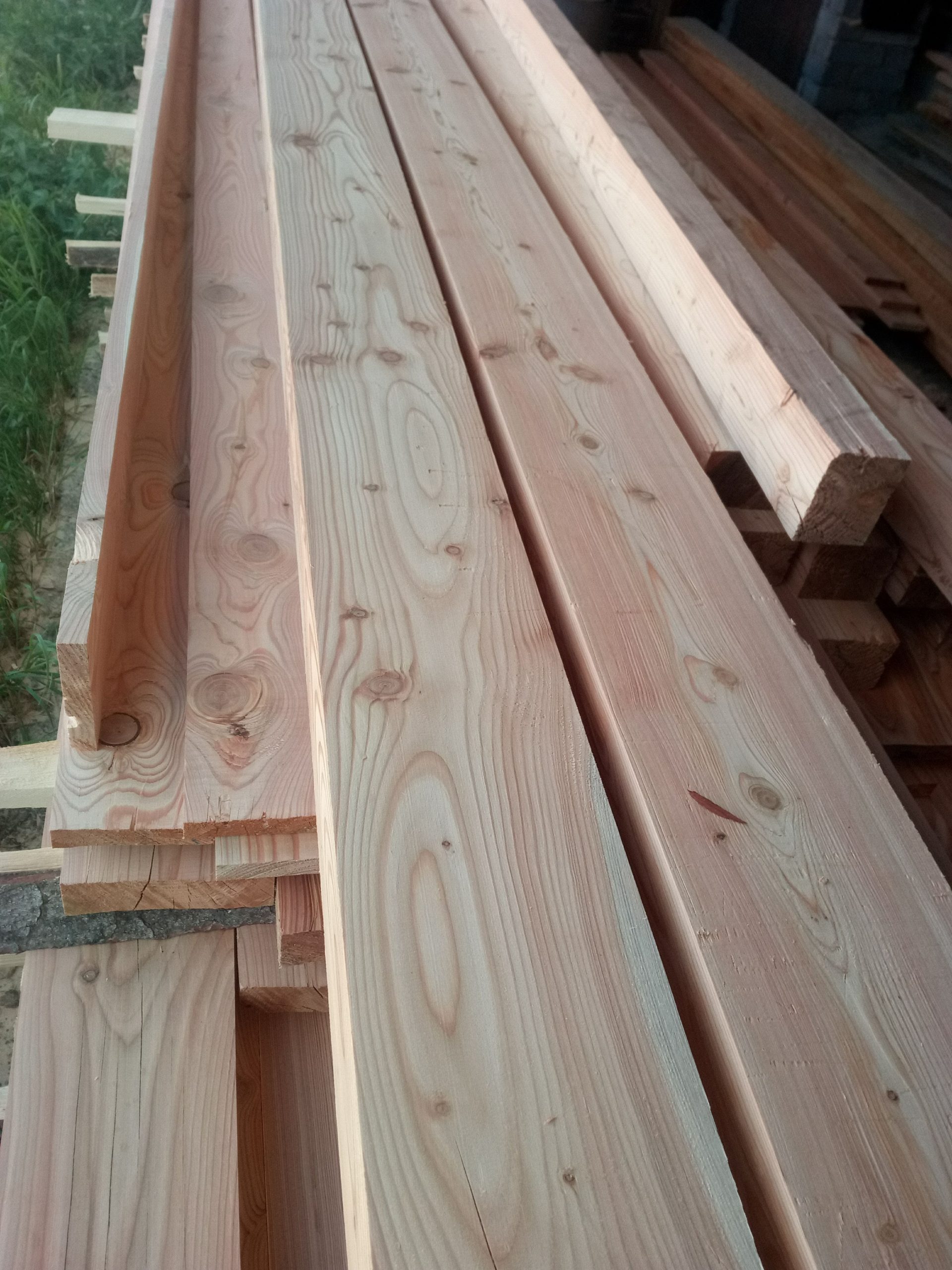Larch wood for construction, planed dried for raised beds, for terrace, pergola, facade, garden, gazebo, stairs. We produce and deliver larch wood for your construction – beams, planks, battens, slats, prisms to order.

PROPERTIES OF LARCH WOOD FOR CONSTRUCTION?
Larch wood, obtained from a deciduous conifer, is highly valued in the construction industry for its unique properties. Its main characteristics include:
Strength and hardness
Larch wood is known for its high strength and hardness, making it an ideal material for structures that require durability and stability. Its density is close to oak wood, which ensures excellent mechanical properties.
Rot and pest resistance
The high resin content in larch wood gives it natural protection against rot and pest attack. This property is crucial for outdoor applications where the wood is exposed to the elements.
Workability
Despite its hardness, larch wood is easy to work with. It is easy to cut and machine, making it easy to use in various construction and carpentry projects.
Aesthetics
The wood has an attractive appearance, with a yellowish sapwood and a dark red to purple heartwood. The pronounced annual rings and beautiful grain pattern contribute to its decorative value, making it popular for both interior and exterior applications.
Larch wood applications
Building construction : Used for timber frame foundations and other building elements.
Garden furniture and patios : Its moisture resistance makes it ideal for outdoor furniture and patios.
Facades and cladding : Larch boards are often used for building cladding for aesthetic appearance and protection from weather conditions.
Interior applications : Suitable for furniture, flooring and wall cladding.
Larch wood is a versatile material with excellent physical properties, ideal for a wide range of construction applications. Its combination of strength, durability and aesthetic appearance makes it the preferred choice for architects and builders.
WHAT IS THE PROCESS OF IMPREGNATING LARCH WOOD FOR CONSTRUCTION?
Impregnation of larch wood is a key process to ensure its longevity and protection against pests and fungi. This process includes several important steps:
Wood preparation
Before impregnation, it is essential to thoroughly prepare the wood . This includes sanding the surface to remove imperfections and ensure good adhesion of the impregnation. It is recommended to use sandpaper with a grit of 60 to 120, and if the wood is planed, it should be lightly sanded with sandpaper with a grit of
Vacuum pressure impregnation
Impregnation takes place in a vacuum pressure chamber , where special impregnation salts such as Wolmanit are used. These salts are introduced deep into the wood structure, which ensures long-term protection against wood-destroying fungi and pests. Pressure impregnation is an effective method that ensures that the protective substances penetrate the wood deeply.
Treatment after impregnation
After impregnation, it is important to carry out further treatment of the wood. It is recommended to first coat with a base oil, which protects the wood from rotting and blueing. Subsequently, a water-based glaze or oil can be applied, which further increases the protective properties.
Special attention to pitch
Larch wood can release resin, which can affect the adhesion of paints. The resin must be removed with suitable solvents before applying paints.
Long-term maintenance
To ensure the longest possible lifespan of larch wood, it is recommended to regularly check the condition of the impregnation and carry out maintenance as necessary to prevent damage caused by moisture or pests. This process of impregnation of larch wood not only increases its resistance, but also extends its lifespan outdoors, which is essential for the construction of various structures such as fences, pergolas or garden furniture.
BEST METHODS FOR INSTALLING LARCH WOOD IN CONSTRUCTION?
Larch wood is a popular material for a variety of building applications due to its natural durability, strength and weather resistance. When installing larch wood, it is important to consider several key methods and techniques.
Material preparation
Choosing quality wood: The quality of larch wood is essential. It is ideal to use wood from natural areas such as Jesenice, which has a high resin content, which ensures natural impregnation and protection against fungi.
Wood drying: Wood should be thoroughly dried to minimize the risk of warping after installation. Slow drying wood achieves better results.
Assembly techniques
Using Shingles: Wooden shingles made from larch wood are a traditional and effective method of covering roofs. The shingles should be carefully crafted and installed to ensure their long life.
Board profiling: When choosing boards for cladding, it is important to choose the right profile. A stepped profile is suitable for outdoor applications, while a straight profile can be used universally.
Recommended distances: When installing larch decking boards, it is important to adhere to the recommended distances between the base joists to ensure structural stability.
Protection and maintenance
Impregnation: Although larch wood has natural resistance, it may be useful to apply protective agents to increase its lifespan, especially outdoors.
Regular maintenance: Checking the condition of the wood and any surface treatment will help extend the life of larch structures.
Send us a quick request
you can also find us at:


